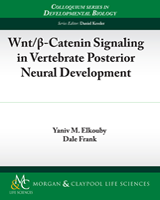NCBI Bookshelf. A service of the National Library of Medicine, National Institutes of Health.
Elkouby YM, Frank D. Wnt/β-Catenin Signaling in Vertebrate Posterior Neural Development. San Rafael (CA): Morgan & Claypool Life Sciences; 2010.
In reviewing the activity of the Wnt/β-catenin pathway during neural development, we attempted to analyze gene regulatory networks acting downstream to Wnt/β-catenin that control A–P patterning of the developing vertebrate nervous system. In many embryonic contexts, significant data have accumulated regarding transcription factors that are direct targets of the Wnt/β-catenin pathway and mediate its morphogenic activity. Table 11.1 lists these transcription factors. The future construction of such regulatory networks is crucial for advancing our knowledge and understanding of how the Wnt morphogen functions during normal development. Understanding the role of these players in the network will further help to understand the principles of morphogen activities in general. Because both Wnt and other “developmental” signaling molecules and transcription factors are involved in tumorigenesis of many cancer types, elucidating these networks may enable us to gain important insights on their aberrant function in disease.
TABLE 11.1
Direct-target transcription factors of Wnt/β-catenin that mediate its morphogenic activity to induce different regions of the posterior nervous system.
In the vertebrate embryo, many cell types differentiate under very similar conditions, all involving Wnt/β-catenin activity. A delicate balance of differential Wnt and other factors’ activities must elegantly distinguish between all the available cell fates. In addition, new components of the pathway, acting either ubiquitously, or in a cell type-specific manner, are still being rapidly discovered. Along with the continuous search for downstream signal-mediating transcription factors, and the biochemical analysis of the pathway, the future challenge is to further dissect the function of individual Wnt ligands, pathway components, and interacting proteins, in different potential inducing tissues at varying developmental time windows, and at higher cellular resolution. Screens for identifying new relevant proteins in genetic models such as the zebrafish and mouse, and classic embryological explantation and transplantation experiments in the Xenopus and chick embryos, together with molecular tools such as MO knockdown and high-throughput genomic and bioinformatic analyses, hold the promise of accomplishing this challenging goal.
- Concluding Remarks - Wnt/β-Catenin Signaling in Vertebrate Posterior Neural Deve...Concluding Remarks - Wnt/β-Catenin Signaling in Vertebrate Posterior Neural Development
Your browsing activity is empty.
Activity recording is turned off.
See more...
